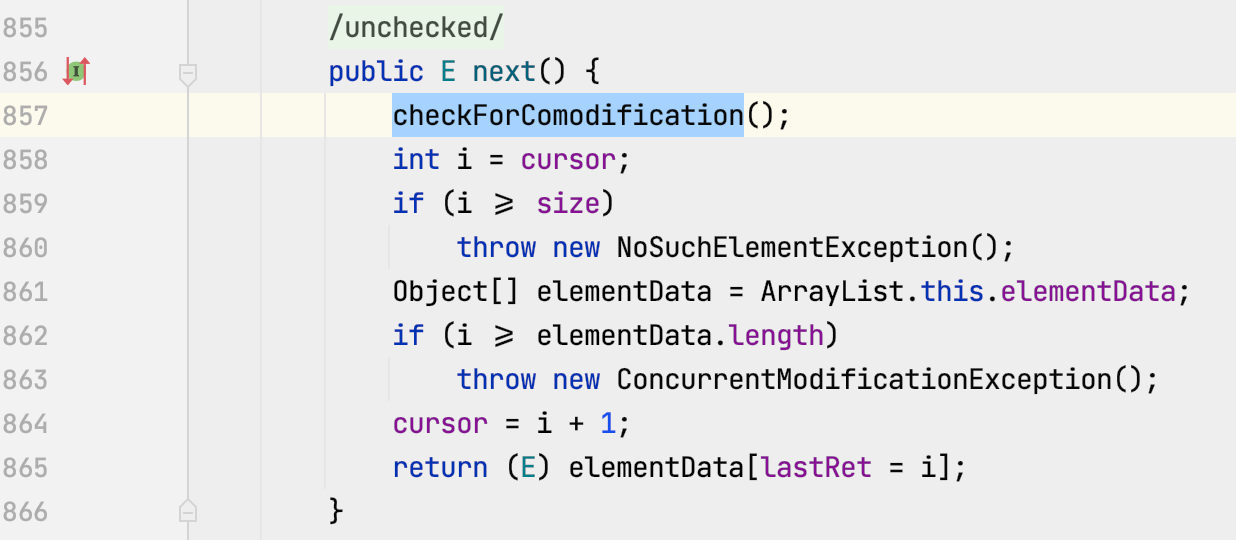您好,登錄后才能下訂單哦!
您好,登錄后才能下訂單哦!
本篇內容主要講解“繞過迭代器遍歷時的數據修改異常的方法有哪些”,感興趣的朋友不妨來看看。本文介紹的方法操作簡單快捷,實用性強。下面就讓小編來帶大家學習“繞過迭代器遍歷時的數據修改異常的方法有哪些”吧!
既然是繞過迭代器遍歷時的數據修改異常,那么有必要先看一下是什么樣的異常。如果在集合的迭代器遍歷時嘗試更新集合中的數據,比如像下面這樣,我想輸出 Hello,World,Java,迭代時卻發現多了一個 C++ 元素,如果直接刪除掉的話。
List<string> list = new ArrayList<>();
Collections.addAll(list, "Hello", "World", "C++", "Java");
// 我想輸出 Hello,World,Java,迭代時發現多一個 C++,所以直接刪除掉。
Iterator iterator = list.iterator();
System.out.println(iterator.next());
System.out.println(iterator.next());
list.remove("C++");
System.out.println(iterator.next());<!-- more -->
那么我想你一定會遇到一個異常 ConcurrentModificationExceptio 。
Hello World java.util.ConcurrentModificationException at java.util.ArrayList$Itr.checkForComodification(ArrayList.java:907) at java.util.ArrayList$Itr.next(ArrayList.java:857) at com.wdbyte.lab.jdk.ModCountDemo.updateCollections(ModCountDemo.java:26)
這個異常在剛開始學習 Java 或者使用其他的非線程安全的集合過程中可能都有遇到過。導致這個報錯出現的原因就和我們操作的一樣,對于某些集合,不建議在遍歷時進行數據修改,因為這樣會數據出現不確定性。
那么如何繞過這個錯誤呢?這篇文章中腦洞大開的三種方式一定不會讓你失望。
這不是一篇源碼分析的文章,但是為了介紹繞過這個異常出現的原因,還是要提一下的,已經知道的同學可以直接跳過。
根據上面的報錯,可以追蹤到報錯位置 ArrayList.java 的 857 行和 907 行,追蹤源碼可以發現在迭代器的 next 方法的第一行,調用了 checkForComodification() 方法。

而這個方法直接進行了一個把變量 modCount 和 expectedModCount 進行了對比,如果不一致就會拋出來 ConcurrentModificationException 異常。
final void checkForComodification() {
if (modCount != expectedModCount)
throw new ConcurrentModificationException();
}那么 modCount 這個變量存儲的是什么信息呢?
/**
* The number of times this list has been <i>structurally modified</i>.
* Structural modifications are those that change the size of the
* list, or otherwise perturb it in such a fashion that iterations in
* progress may yield incorrect results.
*
* <p>This field is used by the iterator and list iterator implementation
* returned by the {@code iterator} and {@code listIterator} methods.
* If the value of this field changes unexpectedly, the iterator (or list
* iterator) will throw a {@code ConcurrentModificationException} in
* response to the {@code next}, {@code remove}, {@code previous},
* {@code set} or {@code add} operations. This provides
* <i>fail-fast</i> behavior, rather than non-deterministic behavior in
* the face of concurrent modification during iteration.
*
* </p><p><b>Use of this field by subclasses is optional.</b> If a subclass
* wishes to provide fail-fast iterators (and list iterators), then it
* merely has to increment this field in its {@code add(int, E)} and
* {@code remove(int)} methods (and any other methods that it overrides
* that result in structural modifications to the list). A single call to
* {@code add(int, E)} or {@code remove(int)} must add no more than
* one to this field, or the iterators (and list iterators) will throw
* bogus {@code ConcurrentModificationExceptions}. If an implementation
* does not wish to provide fail-fast iterators, this field may be
* ignored.
*/
protected transient int modCount = 0;直接看源碼注釋吧,直接翻譯一下意思就是說 modCount 數值記錄的是列表的結構被修改的次數,結構修改是指那些改變列表大小的修改,或者以某種方式擾亂列表,從而使得正在進行的迭代可能產生不正確的結果。同時也指出了這個字段通常會在迭代器 iterator 和 listIterator 返回的結果中使用,如果 modCount 和預期的值不一樣,會拋出 ConcurrentModificationException 異常。
而上面與 modCount 進行對比的字段 expectedModCount 的值,其實是在創建迭代器時,從 modCount 獲取的值。如果列表結構沒有被修改過,那么兩者的值應該是一致的。
上面分析了異常產生的位置和原因,是因為 modCount 的當前值和創建迭代器時的值有所變化。所以第一種思路很簡單,我們只要能讓兩者的值一致就可以了。在源碼 int modCount = 0; 中可以看到 modCount 的數據類型是 INT ,既然是 INT ,就是有數據范圍,每次更新列表結構 modCount 都會增1,那么是不是可以增加到 INT 數據類型的值的最大值溢出到負數,再繼續增加直到變回原來的值呢?如果可以這樣,首先要有一種操作可以在更新列表結構的同時不修改數據。為此翻閱了源碼尋找這樣的方法。還真的存在這樣的方法。
public void trimToSize() {
modCount++;
if (size < elementData.length) {
elementData = (size == 0)
? EMPTY_ELEMENTDATA
: Arrays.copyOf(elementData, size);
}
}上來就遞增了 modCount,同時沒有修改任何數據,只是把數據的存儲進行了壓縮。
List<string> list = new ArrayList<>();
Collections.addAll(list, "Hello", "World", "C++", "Java");
list.listIterator();
Iterator iterator = list.iterator();
System.out.println(iterator.next());
System.out.println(iterator.next());
list.remove("C++");
// 40 多億次遍歷,溢出到負數,繼續溢出到原值
for (int n = Integer.MIN_VALUE; n < Integer.MAX_VALUE; n++) ((ArrayList) list).trimToSize();
System.out.println(iterator.next());正確輸出了想要的 Hello,World,Java 。
分析一下我們的代碼,每次輸出的都是 System.out.println(iterator.next());。可以看出來是先運行了迭代器 next 方法,然后才運行了System.out 進行輸出。所以第二種思路是先把第三個元素C++ 更新為Java ,然后啟動一個線程,在迭代器再次調用 next 方法后,把第四個元素移除掉。這樣就輸出了我們想要的結果。
List<string> list = new ArrayList<>();
Collections.addAll(list, "Hello", "World", "C++", "Java");
list.listIterator();
Iterator iterator = list.iterator();
System.out.println(iterator.next());
System.out.println(iterator.next());
// 開始操作
list.set(2, "Java");
Phaser phaser = new Phaser(2);
Thread main = Thread.currentThread();
new Thread(() -> {
synchronized (System.out) {
phaser.arriveAndDeregister();
while (main.getState() != State.BLOCKED) {
try {
Thread.sleep(100);
} catch (InterruptedException e) {
e.printStackTrace();
}
}
list.remove(3);
}
}).start();
phaser.arriveAndAwaitAdvance();
System.out.println(iterator.next());
// 輸出集合
System.out.println(list);
/**
* 得到輸出
*
* Hello
* World
* Java
* [Hello, World, Java]
*/正確輸出了想要的 Hello,World,Java 。這里簡單說一下代碼中的思路,Phaser 是 JDK 7 的新增類,是一個階段執行處理器。構造時的參數 parties 的值為2,說明需要兩個參與方完成時才會進行到下一個階段。而 arriveAndAwaitAdvance 方法被調用時,可以讓一個參與方到達。
所以線程中對 System.out 進行加鎖,然后執行 arriveAndAwaitAdvance 使一個參與方報告完成,此時會阻塞,等到另一個參與方報告完成后,線程進入到一個主線程不為阻塞狀態時的循環。
這時主線程執行 System.out.println(iterator.next()); 。獲取到迭代器的值進行輸出時,因為線程內的加鎖原因,主線程會被阻塞。知道線程內把集合的最后一個元素移除,線程處理完成才會繼續。
在創建集合的時候為了減少錯誤概率,我們會使用泛型限制放入的數據類型,其實呢,泛型限制的集合在運行時也是沒有限制的,我們可以放入任何對象。所以我們可以利用這一點做些文章。
List<string> list = new ArrayList<>();
Collections.addAll(list, "Hello", "World", "C++", "Java");
list.listIterator();
Iterator iterator = list.iterator();
System.out.println(iterator.next());
System.out.println(iterator.next());
// 開始操作
((List)list).set(2, new Object() {
public String toString() {
String s = list.get(3);
list.remove(this);
return s;
}
});
System.out.println(iterator.next());代碼里直接把第三個元素放入了一個魔法對象,重寫了 toString() 方法,內容是返回集合的第四個元素,然后刪除第三個元素,這樣就可以得到想要的 Hello,World,Java 輸出。
到此,相信大家對“繞過迭代器遍歷時的數據修改異常的方法有哪些”有了更深的了解,不妨來實際操作一番吧!這里是億速云網站,更多相關內容可以進入相關頻道進行查詢,關注我們,繼續學習!
免責聲明:本站發布的內容(圖片、視頻和文字)以原創、轉載和分享為主,文章觀點不代表本網站立場,如果涉及侵權請聯系站長郵箱:is@yisu.com進行舉報,并提供相關證據,一經查實,將立刻刪除涉嫌侵權內容。